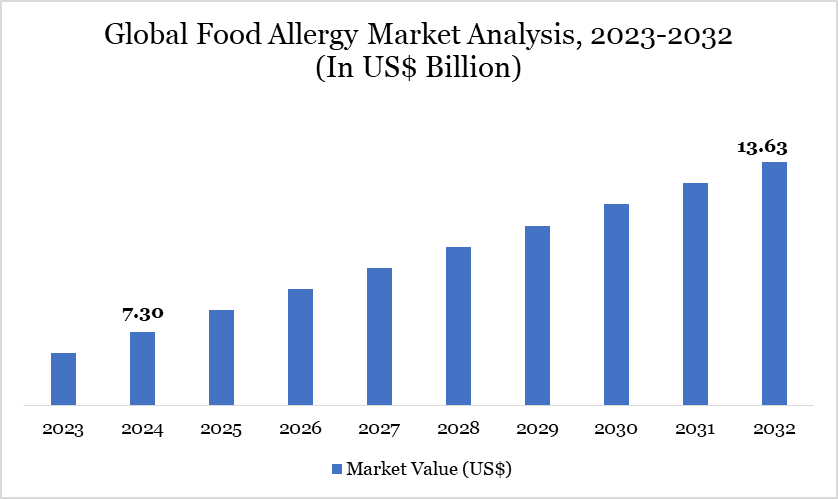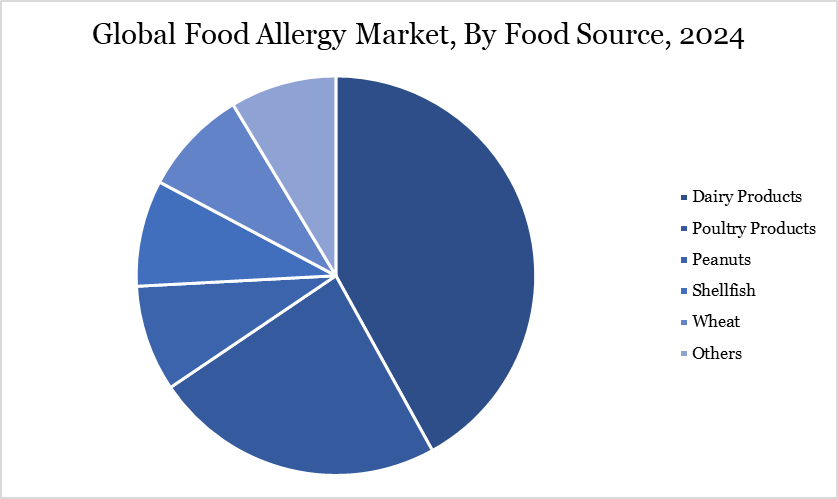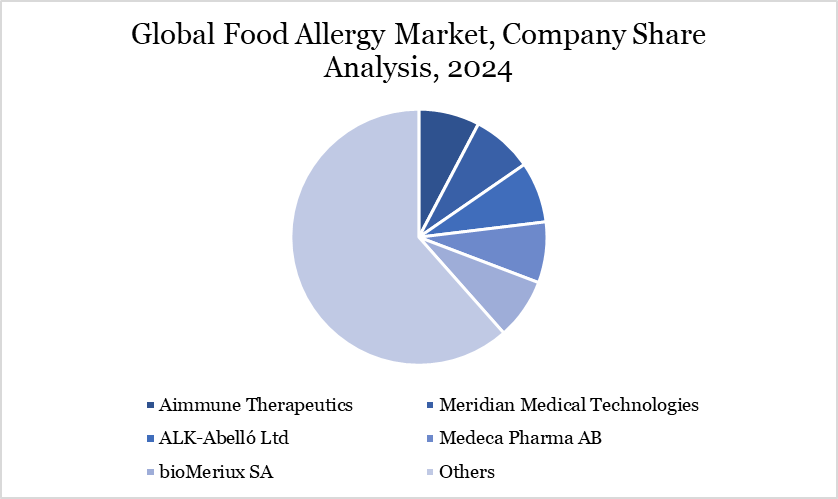Food Allergy Market Size
Food Allergy Market size reached US$ 7.30 billion in 2024 and is expected to reach US$ 13.63 billion by 2032, growing with a CAGR of 8.12% during the forecast period 2025-2032.
The food allergy market is witnessing significant growth, driven by increasing prevalence and heightened awareness. In the US, approximately 33 million individuals are affected by food allergies, with 3.4 million emergency visits annually due to severe reactions.
In the UK, the Food Standards Agency reports that 6% of adults have clinically confirmed food allergies, emphasizing the need for effective management and treatment solutions. These statistics underscore the escalating demand for accurate diagnostics, therapeutics, and allergen-free food products globally.
Food Allergy Market Trend
A notable trend is the advancement in diagnostic technologies, such as component-resolved diagnostics (CRD), which offer precise identification of allergenic proteins, enhancing patient-specific management plans. Additionally, there is a growing emphasis on early introduction of allergenic foods to infants, as studies suggest that introducing a diverse diet at 9 months can reduce allergy risk by 45% by 18 months.
Regulatory developments, like the US FASTER Act mandating sesame labeling, reflect increased governmental focus on allergen transparency. Furthermore, public-private partnerships are fostering research and education initiatives to combat the rising incidence of food allergies.

For more details on this report – Request for Sample
Market Scope
| Metrics | Details |
| By Food Source | Dairy Products, Poultry Products, Peanuts, Shellfish, Wheat, Others |
| By Diagnosis | Skin Prick Tests, Blood Tests, Component-Resolved Diagnostics (CRD), Others |
| By Treatment | Epinephrine, Antihistamines, Oral Immunotherapy, Others |
| By Distribution Channel | Hospital Pharmacy, Retail Pharmacy, Online Pharmacy |
| By Region | North America, South America, Europe, Asia-Pacific and Middle East and Africa |
| Report Insights Covered | Competitive Landscape Analysis, Company Profile Analysis, Market Size, Share, Growth |
Food Allergy Market Dynamics
Rising Demand for Allergen-Free Products
The global rise in individuals circumventing allergens in food and beverages approximately 500 million, with roughly 85 million in the US alone indicates substantial growth potential in the food allergy market. In the last twenty years, the incidence of food allergies in American youths has escalated roughly fourfold compared to population growth. This phenomenon is not limited to US; evidence suggests a global rise in food allergies, especially in young children in both developed and developing countries.
Recent research by McKinsey & Company indicates that consumers, whether directly impacted by allergies or purchasing for someone who is, frequently encounter stress while navigating grocery aisles to evade allergens. Numerous individuals invest significant time analyzing product labels, with some even eschewing entire categories of products.
Moreover, these consumers often pay a premium for superior, allergen-free products, demonstrating a preference for smaller, allergy-aware firms over larger counterparts, while also seeking new product alternatives. In US, spending on allergen-free supermarket products above the average, with consumers allocating nearly US$ 19 billion yearly to alternatives or allergen-free items. This expenditure is expected to persist in its upward trajectory, highlighting the growth potential within the food allergy sector.
High Cost Of Diagnosis And Medication
The high cost of diagnosing and managing peanut allergies significantly challenges the food allergy sector. Annual incremental healthcare costs per individual range from US$ 330 to 435, with anaphylaxis treatment adding US$ 865 and adrenaline auto-injectors another US$ 510. For the UK, these combined costs total approximately US$ 44–58 million annually. Such expenses can limit access to timely diagnosis and consistent treatment due to financial strain on both patients and healthcare systems.
Rising prices can impede the implementation of preventative strategies, diagnostic procedures and innovative, possibly life-saving treatments. Individuals lacking adequate insurance or financial resources may neglect allergy testing and management, heightening their risk of severe reactions. This constraint affects both patients and hinders the growth of the food allergy market, as elevated costs diminish the accessibility and demand for sophisticated diagnostic equipment, treatments and allergen-free products, hence impeding market progress.
Food Allergy Market Segment Analysis
The global food allergy market is segmented based on food sources, diagnosis, treatment, distribution channel and region.

Natural Segment Driving Food Allergy Market
Peanut allergies dominate the food source segment due to the presence of potent allergenic proteins, including Ara h 1, Ara h 2 and Ara h 3, which are known for their ability to trigger severe allergic reactions. These proteins are particularly resilient, resisting both heat and digestion, which increases the likelihood of a reaction even in trace amounts. Peanut allergy is especially dangerous, as it can cause anaphylaxis a severe, life-threatening allergic response often with very small exposure to the allergen, making peanuts one of the most high-risk allergens globally.
This dominance is further underscored by the fact that peanut allergy is currently the only food allergy with an FDA-approved treatment, Palforzia, highlighting the seriousness and prevalence of peanut-related reactions. Other treatments, such as peanut oral immunotherapy, are in use to increase tolerance to peanut proteins but remain non-FDA-approved. This specialized treatment focus for peanut allergies, combined with the high-risk profile of peanut proteins, positions peanuts as a leading and particularly challenging subsegment in the food allergy market.
Food Allergy Market Geographical Share
Demand for Food Allergy in North America
The demand for food allergy-related products and services in North America is rising due to the growing number of individuals affected by food allergies. According to the US Centers for Disease Control and Prevention (CDC), approximately 6.2% of adults and 5.8% of children in the US had diagnosed food allergies as of 2021, and 33 million Americans got diagnosed with food allergies.
In Canada, Health Canada reports that over 3 million Canadians are affected by food allergies, prompting federal labeling laws and school safety protocols. This increasing prevalence is driving the need for allergen-free foods, accurate labeling, and improved allergy management across public and private sectors.
Sustainability Analysis
The sustainability landscape of the food allergy market is increasingly influenced by regulatory advancements and public health initiatives. The US Food and Drug Administration (FDA) enforces stringent labeling requirements for major food allergens, aiming to prevent undeclared allergens a leading cause of Class I food recalls. The enactment of the Food Allergy Safety, Treatment, Education, and Research (FASTER) Act in 2021 expanded the list of major allergens to include sesame, enhancing transparency and safety for consumers.
Additionally, the US Department of Agriculture (USDA) supports food allergy management in schools, recognizing that over 15% of school-aged children with food allergies have experienced reactions in educational settings. These measures reflect a concerted effort to promote sustainable practices in food production and labeling, ensuring the well-being of individuals with food allergies.
Food Allergy Market Major Players
The major global players in the market include Astellas Pharma, Inc., Aimmune Therapeutics, Meridian Medical Technologies, ALK-Abelló Ltd, Medeca Pharma AB, bioMeriux SA, Omega Diagnostics Group PLC, HYCOR Biomedical, HOB Biotech Group Corp Ltd. and Cambridge Allergy Ltd.

Key Developments
In March 2024, Gold Standard Diagnostics introduced the inaugural product of the new allergy PowerLine tests: the SENSIStrip Gluten PowerLine Lateral Flow Device. The device features a sensitive detection technology utilizing a monoclonal antibody to identify gluten residues in food matrices, rinse water and swabs.
In March 2024, ALS significantly enhanced and fortified its footprint in the Life Sciences sectors of Europe and US. ALS has acquired York Analytical Laboratories, located in Northeast US and Wessling Holding GmbH & Co., based in Western Europe.
In February 2024, Mérieux NutriSciences inaugurated a state-of-the-art laboratory for food analysis in Maringá, Brazil. The newly established facility possesses federal CGRE/IMMETRO accreditation in accordance with NBR ISO/IEC 17025 standards, aimed at assisting the food industry in achieving quality benchmarks.
Why Choose DataM?
Data-Driven Insights: Dive into detailed analyses with granular insights such as pricing, market shares and value chain evaluations, enriched by interviews with industry leaders and disruptors.
Post-Purchase Support and Expert Analyst Consultations: As a valued client, gain direct access to our expert analysts for personalized advice and strategic guidance, tailored to your specific needs and challenges.
White Papers and Case Studies: Benefit quarterly from our in-depth studies related to your purchased titles, tailored to refine your operational and marketing strategies for maximum impact.
Annual Updates on Purchased Reports: As an existing customer, enjoy the privilege of annual updates to your reports, ensuring you stay abreast of the latest market insights and technological advancements. Terms and conditions apply.
Specialized Focus on Emerging Markets: DataM differentiates itself by delivering in-depth, specialized insights specifically for emerging markets, rather than offering generalized geographic overviews. This approach equips our clients with a nuanced understanding and actionable intelligence that are essential for navigating and succeeding in high-growth regions.
Value of DataM Reports: Our reports offer specialized insights tailored to the latest trends and specific business inquiries. This personalized approach provides a deeper, strategic perspective, ensuring you receive the precise information necessary to make informed decisions. These insights complement and go beyond what is typically available in generic databases.
Target Audience 2024
Manufacturers/ Buyers
Industry Investors/Investment Bankers
Research Professionals
Emerging Companies